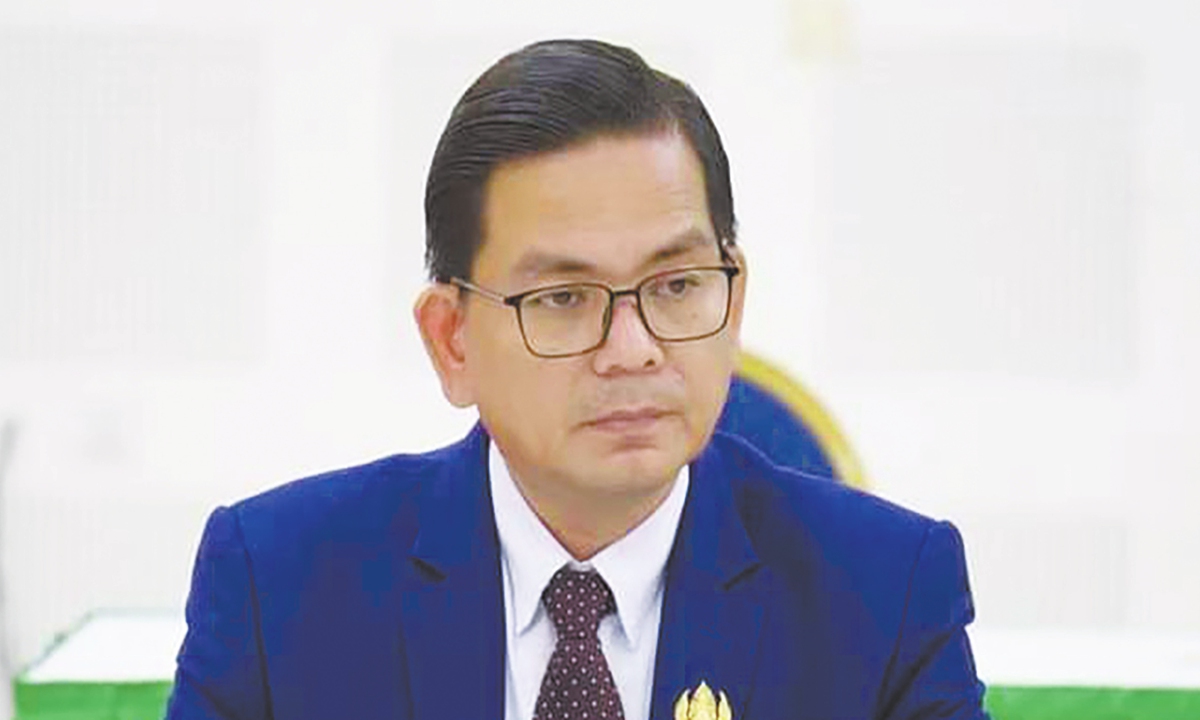
Photo: VCG
Editor's Note:
Chinese President Xi Jinping is currently in Cambodia for a state visit, following his visits to Vietnam and Malaysia. What significance do high-level exchanges between the two countries hold for elevating bilateral relations? What new impetus will this visit provide for building a high-quality, high-level and high-standard China-Cambodia community with a shared future in the new era? Global Times (GT) reporters Wang Wenwen and Xing Xiaojing interviewed Kin Phea (Kin), director general of the International Relations Institute of the Royal Academy of Cambodia, regarding these issues.
GT: Regarding Xi's ongoing visit to Cambodia, what are your expectations? What key areas or topics are you focusing on? What significance do high-level exchanges between the two countries hold for elevating bilateral relations?
Kin: The high-level visit by the Chinese leader is a historic opportunity to deepen our comprehensive strategic partnership. We expect significant outcomes in trade, infrastructure, digital economy, education and people-to-people exchanges. This visit will further strengthen political trust and reinforce our shared vision for common development.
High-level exchanges are crucial - they serve as a platform for aligning strategic priorities, boosting mutual confidence and opening new chapters of cooperation. This visit is a powerful driver to elevate our already strong ties, ensuring long-term peace, stability, prosperity, and friendship for both nations and the broader region.
GT: In the face of complex international and regional landscapes, China-Cambodia relations have continued to strengthen. How do you assess the development trend of the bilateral relationship in recent years? What is the significance of this ironclad friendship in maintaining regional peace and stability and promoting common development?
Kin: China-Cambodia relations have been at the highest level ever in history and advanced with remarkable momentum, built on deep mutual trust and shared development goals. This "ironclad friendship" has consistently delivered results, even amid global uncertainties. Over the years, the two countries have forged and nurtured this unbreakable, ironclad friendship that has weathered many storms and overcome many difficulties. Special and unbreakable ties between China and Cambodia serve as a unique role model for interstate relations that can be replicated both regionally and globally. Joint efforts in diplomacy, trade and security enhance peace and prosperity, while close coordination on global platforms strengthens multilateralism. Cambodia greatly values this partnership, which contributes not only to our national development but also to regional harmony. The enduring strength of our ties demonstrates the power of genuine friendship based on equality, respect and mutual support.

Kin Phea Photo: Courtesy of Kin
GT: As you just mentioned, the relationship between China and Cambodia is often described as that of "ironclad friends," and Cambodia has always pursued a foreign policy of neutrality and pragmatism. How does Cambodia maintain a balance in its diplomacy with major powers?
Kin: Cambodia values its "ironclad friendship" with China while maintaining a balanced, neutral and pragmatic foreign policy. Our relations with China are built on mutual respect, trust and strategic alignment. We believe in fostering cooperation that brings tangible benefits to our people while remaining open to partnerships with all countries based on sovereign equality. Cambodia continues to play a constructive role in regional diplomacy, seeking peace and development through inclusive engagement. As we strengthen ties with China, we will also ensure balanced diplomacy with other major powers, pursuing an independent foreign policy that prioritizes national interests and promotes regional and global stability and harmony.
GT: China has remained Cambodia's largest source of foreign investment and its largest trading partner for many years. China is ready to work with Cambodia to continuously enrich their "Diamond Hexagon" cooperation framework, and accelerate the synergy between the Belt and Road Initiative (BRI) and Cambodia's Pentagonal Strategy. How do you evaluate the progress of China-Cambodia economic and trade cooperation? What are the potential areas where breakthroughs can be made?
Kin: China-Cambodia economic cooperation has made tremendous strides, particularly under the "Diamond Hexagon" cooperation framework and synergy between the BRI and the Pentagonal Strategy. Under this synergy, the Industrial and Technological Corridor in Preah Sihanouk province is envisioned as a "second Shenzhen" - and the Fish and Rice Corridor in northwestern Cambodia will enhance agricultural productivity and ecological sustainability. Infrastructure, agriculture, trade and industrial development have all seen significant progress.
Moving forward, we see immense potential in green development, digital transformation, vocational training and high-tech industries. These new growth areas can uplift Cambodia's economic competitiveness while bringing innovation and opportunities to our people. China's continued investment and partnership are vital to our development journey. Together, we can build a resilient, inclusive and future-oriented economic relationship that benefits both countries and the broader region.
GT: In the first two months of this year, trade between China and ASEAN reached 1.03 trillion yuan ($140 billion), growing by 4 percent and accounting for 15.8 percent of China's total foreign trade. ASEAN remains China's largest trading partner. How does the economic development of China and Southeast Asia contribute to revitalizing the global economy? In the face of rising unilateralism and hegemonic bullying, what role does ASEAN play in the international arena?
Kin: The robust growth in China-ASEAN trade reflects the vitality of regional cooperation and its contribution to global economic recovery. China and Southeast Asia are engines of growth, resilience and innovation. As ASEAN's largest trading partner, China's partnership with the region offers inclusive development and balanced globalization. In an era challenged by protectionism and unilateralism, ASEAN plays a stabilizing role - promoting multilateralism, regional connectivity and open trade. China-ASEAN relations have entered a new stage of comprehensive strategic partnership, from which their cooperation can only deepen and mutual benefit can only increase. Cambodia, as an active ASEAN member, supports this vision. We believe that through closer ASEAN-China collaboration, we can build a more dynamic, peaceful and prosperous Asia that contributes positively to the global economy.
GT: Given the complex and ever-changing current international situation, what role can the robust China-Cambodia relationship play in the conduct of China's neighborhood diplomacy? Looking ahead, what exemplary role can the China-Cambodia relationship play in the practice of building a community with a shared future with neighboring countries?
Kin: The Cambodia-China relationship is a cornerstone of China's neighborhood diplomacy, promoting harmony, development and shared prosperity. Our partnership exemplifies how mutual respect, non-interference and win-win cooperation can lead to enduring peace and regional stability. As global challenges grow more complex, this relationship provides a successful model for others. Looking ahead, we believe Cambodia and China can lead by example in advancing the vision of a community with a shared future - one built on peace, inclusivity and common development. Together, we can contribute positively to global governance and inspire partnerships that prioritize humanity's collective well-being.



